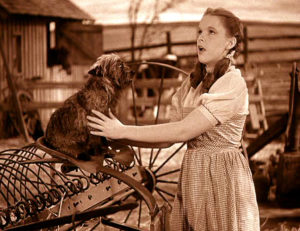“The Wizard of Oz” is a timeless story – a tale of a young girl’s desire to leave home for a better life; but a life, she finds, that was right before her eyes the entire time. Best remembered as an Oscar-winner for ‘Best Original Song’ for “Somewhere Over the Rainbow,” “Oz” would make keen observations on life, love, and coming of age in the process.
While color within black and white is an established tool for modern filmmakers (the little girl’s red coat in “Schindler’s List”/a villain’s yellow skin in “Sin City”), “The Wizard of Oz” – while not the first to use this gimmick – popularized it and made it accessible to a wider audience. Filmed on a Technicolor camera, “Oz” displays the technology of the era – specifically the color derived from its camera that combined the negatives of blue, red, and green to make a full color print. Observe the sepia-drenched dolor of Kansas in the film’s beginning and compare it with later scenes, such as the splendor of the Emerald City or the vibrancy of Dorothy’s ruby slippers.
The majesty of the film is deeper still given it was filmed during the Great Depression. Audiences suffering from hunger and poverty were doubtless awed at the sight of Oz’s wide color palette, its hallmark the luminescent Yellow Brick Road.
The plot is well known yet simple. A young girl (Judy Garland) runs away to save her dog Toto from the clutches of an evil town matron named Miss Gulch (Margaret Hamilton). However a tornado sweeps her away to the land of Oz – where she finds, much to her dismay, that the events in Kansas still plague her. She longs to return home to her aunt (Clara Blandick), but must first make it to the mysterious Wizard of Oz and escape the threats of the Wicked Witch of the West.

Amidst all this, “Oz” seeks to be both an entertaining buddy tale and coming of age family film, and it accomplishes this with ease.
Garland shines as the star of “The Wizard of Oz,” bringing authenticity and realness to the role of Dorothy. She appears timid for much of the film, her ultimate acts of bravery sandwiched between fear and apprehension. Dorothy’s actions come from a place of love, and Garland’s facial expressions and humble nature make “Oz’s” more memorable moments stick. Watch her plead with Miss Gulch (who cleverly becomes the Wicked Witch once Dorothy reaches Oz) to not hurt Toto early in the film, and contrast this with her later sticking up for the Lion as he cowers before The Wizard. “Oz” is about growth – Dorothy grows from one afraid to confront her problems early in the film to one who earns redemption at the hands of the friends she makes and the revelations she finds within herself.
Regrettably Garland (who took the role of Dorothy when MGM couldn’t sign Shirley Temple) would later detail personal abuses – both of molestation and forced drug use – that highlight some of Hollywood’s darker tendencies. However, there’s no trace of darkness in her performance. At just 17 years of age, Garland shows an amazing screen presence and likability, imbuing Dorothy with an endearing innocence despite it. She clicks her heels and recites the now-classic “There’s no place like home.” And, after the adventures she’s seen, and the tears she’s cried over leaving Auntie Em, we believe it.
Under it all, however, “The Wizard of Oz” is an endearing family film and holds up over the years. It’s childlike and innocent, phrases like “Jiminy Cricket” answering for swear words, its lessons of family and togetherness resonating with children and adults alike. From its band of Munchkins at the film’s opening, to Glinda the Good Witch, to its array of pleasing songs, the film entertains and makes you think – a credit to its writing, acting, and direction. “The Wizard of Oz” is a timeless and pleasing film you can watch again and again.
– by Mark Ziobro